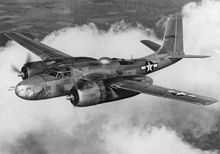Air raid on Dinslaken in 1945
The air raid on Dinslaken took place on Friday, March 23, 1945. US air forces carried out heavy air strikes on Dinslaken on the Lower Rhine as part of Operation Flashpoint (American part of Operation Plunder ) . The aim of this air raid was to prepare the American forces to cross the Rhine between Wesel and Dinslaken.
Even before the heavy attacks in March 1945, Dinslaken was repeatedly the target of smaller Allied air raids, which, however, did not cause any major destruction.
background
In reconnaissance photos, various air defense positions around Dinslaken (Neukölln battle position in the east of the municipality - today the Hiesfeld district ) were identified, which were set up to protect the neighboring industrial sites ( Ruhrchemie Oberhausen and Duisburger Hüttenwerke). In addition, Dinslaken itself was the location of a rolling mill of what was then August Thyssen-Hütte . On the outskirts of the community was the Schwarze Heide field airfield , where units of the German Air Force were stationed. These circumstances led to the decision to make the city the target of an air strike.
Course of the air strike
Around 100 bombers of the US 9th Air Fleet were involved in the attack, and they took off from their bases in northern France at around 8:00 a.m. Light to medium-weight bombers of the types Martin B-26 Marauder , Douglas A-20 Havoc and Douglas A-26 Invader were used . The first attack formation reached the target at around 9:30 a.m. The primary targets were the city center and anti-aircraft positions. In a second wave of attacks in the early afternoon, other targets (rolling mill) were bombed. The attack ended around 1:30 p.m.
Consequences of the attack
80% of the city center was destroyed in the heavy air raids. The rolling mill was also hit. The flak positions remained largely intact. The attacks killed 511 people (including 40 slave laborers).
The Wehrmacht had withdrawn from Dinslaken days earlier, and the anti-aircraft guns had been relocated before the attack. A short time after the bombing, the city was occupied by American forces without a fight .
March 23, 1945 went down in city history as “Black Friday”.
literature
- Willi Dittgen: The transition, the end of the 2nd World War in Dinslaken and the surrounding area. 1983.
- Friedhelm van Laak (ed.): Power and powerlessness - reports from Dinslaken on the Lower Rhine. 2006.
- Heinz Ingensiep: Death came on a spring morning - bombs on Dinslaken. Accompanying volume for the special exhibition "1945 - Air War over Dinslaken", 2016.
- Wilhelm Grube: Last Hope '44 - Memories of the Luftwaffe helper - From the children's country dispatch to the flak. In: Publications on history and local history, Volume 21, Association for Home Care Land Dinslaken eV, Dinslaken 1995.
- Heinz Pape: Air Force helper on the Lower Rhine - anti-aircraft aircraft - ground combat - captivity. Edition Octopus, Münster 2008. ISBN 978-3-86582-711-1


